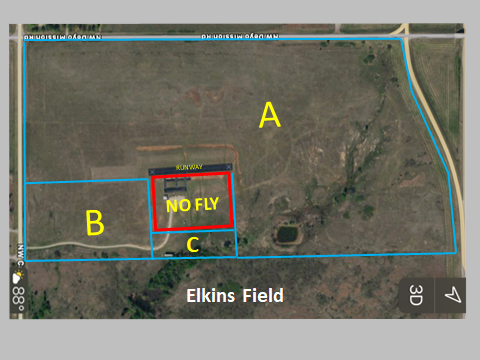(Edition: 15 February 2022)
Field Rules & Safety Guidelines PDF file for download: Field Rules & Safety Guidelines
- Governance: All pilots must be members of the Academy of Model Aeronautics (AMA) and Lawton Area Fun Flyer Society (LAFFS) except for LAFFS’ guest pilots and non-AMA pilots enrolled in the AMA “Intro Pilot Program” under the direct supervision of an AMA-designated LAFFS instructor pilot. All pilots must be familiar with and comply with the AMA Safety Guide, FAA regulations, and Elkins Field Rules and Guidelines. (see http://www.modelaircraft.org). FPV pilots must comply with AMA document 550, Unmanned Aircraft Operations Utilizing First-person View. See: http://www.lawtonareafunflyers.org/blog/category/rules/
- Field Diagram:
Area A: for aircraft operating from the main runway.
Area B: Primarily for sailplanes, park flyers, small foamies, rotorcraft, and others that can’t safely integrate with aircraft operating from the main runway. Aircraft such as sailplanes, etc., climbing to higher altitudes and requiring more area may fly outside of Area B, but use caution not to conflict with aircraft in other areas.
Area C – Corridor: Transition corridor between Areas A and B in either direction. Located between the outhouse and the trailer. Only used in the late afternoon for downwind leg of the east-side traffic pattern when the low western sun prevents traffic patterns being flown safely to the west of the runway. Area C is not for maneuvering (aerobatics, turns, etc). Don’t fly traffic patterns to the east earlier in the day when the sun is high and the normal pattern to the west would be safe. Pilots must use extreme caution to avoid flying over the parking area and to avoid other aircraft operating in Areas A and B.
No-Fly Area: Do not takeoff from, fly approaches over, or land in the designated “No-Fly” area which includes the pit area, pilot boxes, and parking lot.
- Flight Pattern Flow: It is safest when all aircraft are flowing in the same general direction to avoid mid-air collisions. A recommendation is to fly the upwind leg relatively close to the runway and the downwind leg farthest from the runway in a general box pattern around the airfield. Aircraft can still do maneuvers, aerobatics, etc., if at the completion of the maneuver they resume travel that is not opposite the direction of other aircraft in their vicinity, if possible. Try to avoid cutting diagonally across the pattern, especially when there are several aircraft flying. If you plan to spin down through the pattern, a verbal announcement would help others know your intentions.
- Frequency Control: If not using a 2.4 GHz radio system, frequency control is the responsibility of each pilot. Non-2.4 GHz transmitters should have something clearly identifying their channel (frequency flag, channel number tag, etc.), preferably attached to the antenna.
- Pilot boxes: Once in the air, stand in the fenced pilot boxes or no closer to the runway than the pilot boxes. Do not stand on or near the runway.
- Verbal Announcements:
-
- When taxiing onto the runway, announce: “Taking off (or similar words)”
- If walking on to the runway, announce: “On the runway”.
- When leaving the runway announce: “Clear of the runway”.
- When landing, announce: “Landing”.
- When landing without power, announce: “Dead stick”
- When flying in calm winds, announce: “Landing from the north (or south)”. Pilots flying should coordinate among themselves to operate in the same direction.
- Engine-out Aircraft: Pilots shall yield to engine-out (dead stick) aircraft.
- Low-altitude, high-speed passes down the runway are not allowed. Low,
high-speed passes shall be made west of the runway over the grassy area, not directly over the runway. - Visual contact with aircraft: Pilots must maintain direct visual contact (VLOS) at all times with the aircraft they are flying.
- First Pilot View (FPV) flying: Each FPV pilot must have a safety spotter who is an AMA member, is within immediate reach of the controls, and is capable of taking over control and safely flying the aircraft. FPV aircraft must stay within visual contact (VLOS) of the pilot and spotter. FPV pilots must comply with all requirements of AMA Document 550, Unmanned Aircraft Operations Utilizing First-person View. See: http://www.lawtonareafunflyers.org/blog/category/rules/
- Shut Down after flight: When taxing back to the pit area, all propulsion systems shall be shut down prior to crossing the painted white shut-down line on the taxiways. Do not taxi in the pit area or across the surface area that connects the pilot boxes.
- Minimize engine-run noise: Extended and/or repeated engine-run noise can be a safety hazard making it hard for pilots to hear engines in flight and to communicate with other pilots. Preferably, do engine break-in or tuning during parts of the day when others are not there.
- Safety: When at the field, we are all responsible for safety. If you see someone not complying with these rules, please bring it to their attention. If you are uncomfortable doing this, advise the LAFFS Safety Officer or one of the other club officers.
- Visitors/spectators must remain behind the fence unless accompanied by a LAFFS member.
- Field cleanliness: Everyone should help keep the field area clean. Trash cans are provided.
- LAST ONE OUT, LOCK THE GATE. The last person leaving the field MUST lock the gate. Leaving it open risks our lease.
